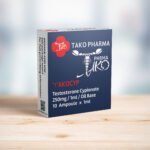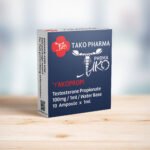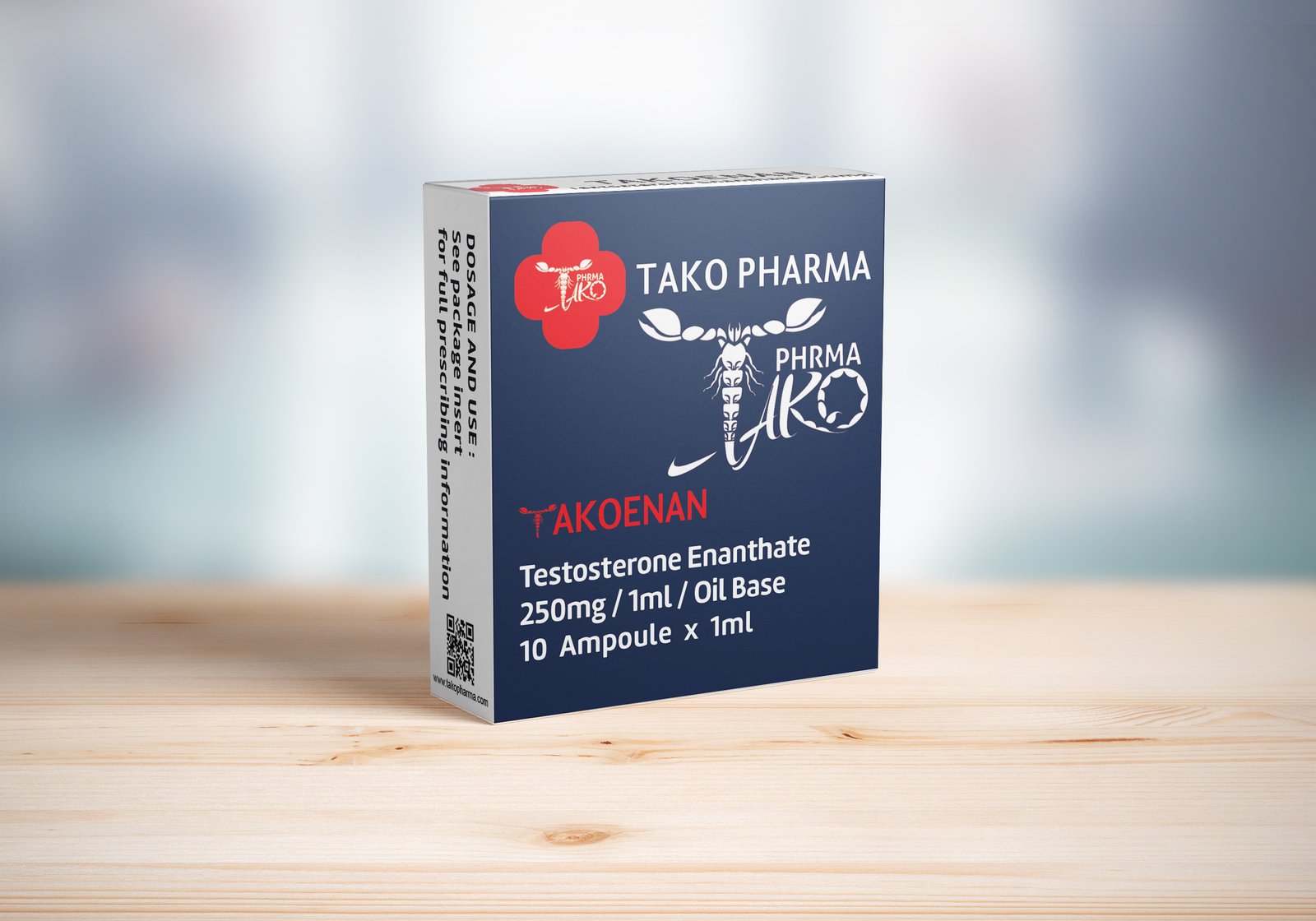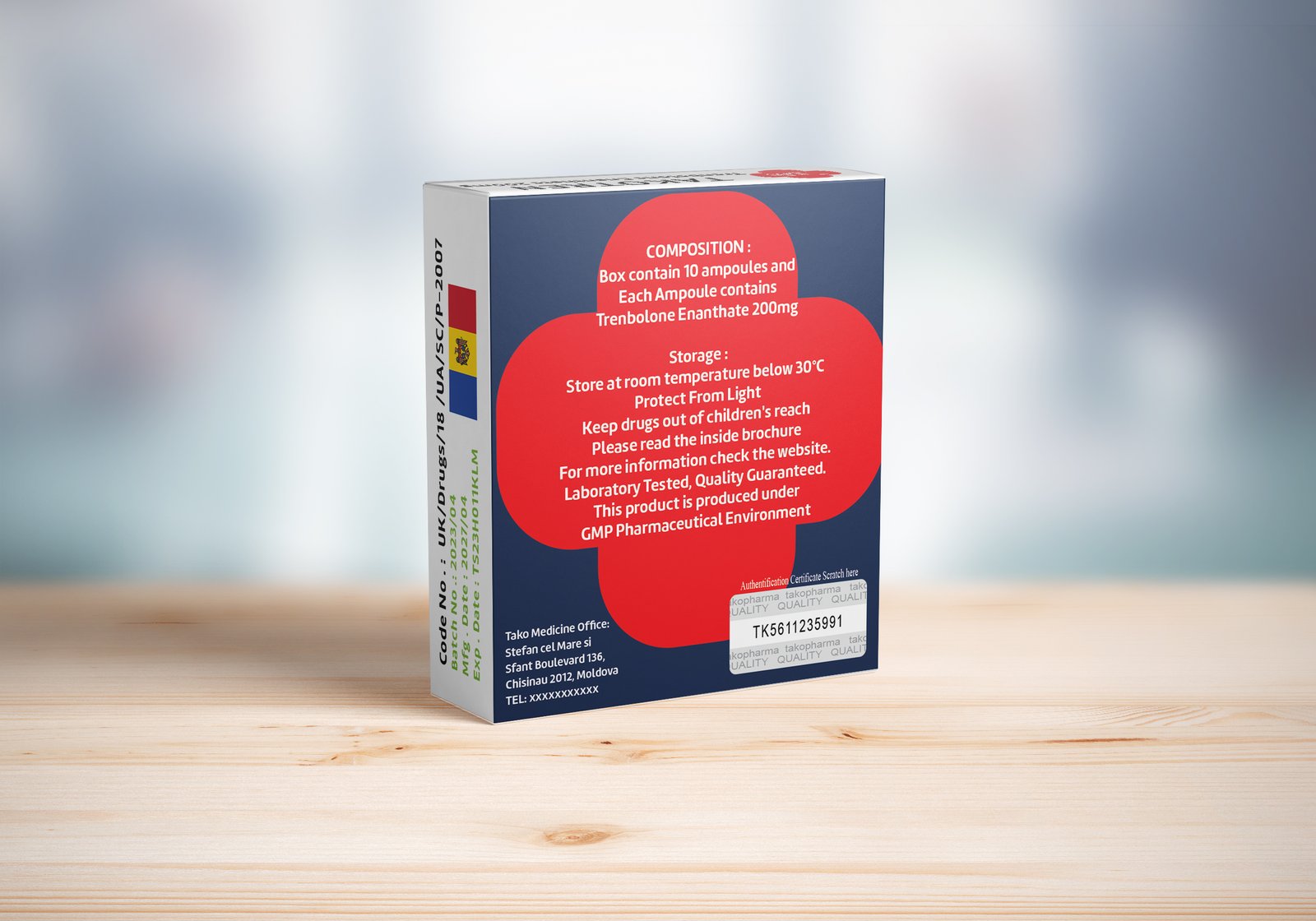
Testosterone Cypionate
June 29, 2024
Testosterone Propionate
June 29, 2024Testosterone Enanthate
Introduction to Testosterone Enanthate
Testosterone Enanthate is a commonly utilized anabolic steroid and hormone replacement therapy (HRT) agent. Structurally, it is a synthetic derivative of testosterone, the primary male sex hormone. The chemical structure of testosterone enanthate involves the esterification of testosterone with the enanthate ester, which significantly impacts its release and half-life in the body.
Mechanistically, testosterone enanthate functions by mimicking the natural effects of endogenous testosterone. Upon administration, it is gradually released into the bloodstream, where it binds to androgen receptors. This binding initiates a cascade of biological processes, including protein synthesis, muscle growth, and the development of male secondary sexual characteristics.
In medical settings, testosterone enanthate is primarily used to treat conditions associated with low testosterone levels, such as hypogonadism. Hypogonadism is characterized by the body’s inability to produce adequate amounts of testosterone, leading to symptoms such as fatigue, decreased libido, and muscle loss. By supplementing with testosterone enanthate, patients can experience a restoration of normal testosterone levels, thereby alleviating these symptoms.
Further applications of testosterone enanthate include its use in transgender hormone therapy, where it aids in the masculinization of transgender men. It is also occasionally prescribed for the treatment of certain types of breast cancer in women, given its anti-estrogenic properties. The controlled administration of testosterone enanthate under medical supervision ensures that its therapeutic benefits are maximized while minimizing potential adverse effects.
In summary, testosterone enanthate plays a pivotal role in various medical treatments by effectively mimicking the functions of natural testosterone. Its carefully regulated use can provide significant health benefits for individuals with testosterone deficiencies or other specific medical conditions. Understanding its chemical structure and mechanism of action is essential for appreciating its therapeutic potential.
Medical Uses of Testosterone Enanthate
Testosterone Enanthate is a synthetic version of the naturally occurring male hormone testosterone. It is primarily prescribed for various medical conditions, most notably hypogonadism, delayed puberty in males, and specific types of breast cancer in women. Hypogonadism, a condition characterized by insufficient testosterone production, is one of the most common reasons for prescribing Testosterone Enanthate. In this scenario, the medication helps to restore normal testosterone levels, thereby alleviating symptoms such as fatigue, depression, and reduced libido.
Additionally, Testosterone Enanthate is utilized in cases of delayed puberty in males. This condition occurs when a young male does not exhibit the physical signs of puberty at the typical age range. By administering Testosterone Enanthate, healthcare providers can stimulate the development of secondary sexual characteristics, including increased muscle mass, deepening of the voice, and growth of facial and body hair. This treatment is typically considered when other underlying causes for delayed puberty have been ruled out.
Interestingly, Testosterone Enanthate also finds its place in the treatment of certain types of breast cancer in women, particularly in postmenopausal patients. The hormone acts by inhibiting the growth of hormone-sensitive cancer cells. However, this application is less common and usually considered when other treatments have not been effective.
The criteria for prescribing Testosterone Enanthate involve a comprehensive evaluation of the patient’s medical history, symptoms, and diagnostic tests, including blood tests to measure testosterone levels. The dosage and administration of Testosterone Enanthate vary depending on the condition being treated. It is typically available in injectable form, with dosages tailored to meet individual patient needs. Regular monitoring by a healthcare provider is essential to ensure efficacy and adjust dosages as necessary.
How Testosterone Enanthate Works
Testosterone Enanthate is a synthetic form of the naturally occurring testosterone hormone, primarily used in hormone therapy for men with low testosterone levels. The pharmacodynamics of Testosterone Enanthate involve its role as an androgen receptor agonist. Once administered, it binds to and activates androgen receptors in various tissues, including muscle, bone, and the central nervous system. This activation triggers a cascade of anabolic processes that promote muscle growth, influence fat distribution, and support overall physiological functions.
Upon intramuscular injection, Testosterone Enanthate is slowly released into the bloodstream. Its pharmacokinetics are characterized by a prolonged half-life, typically ranging from 4 to 10 days, which allows for less frequent dosing compared to other testosterone formulations. The esterification of the hormone enhances its lipid solubility, leading to a gradual release and metabolism in the body. The liver primarily metabolizes Testosterone Enanthate, converting it into active and inactive metabolites that are eventually excreted via urine.
The influence of Testosterone Enanthate on muscle growth is well-documented. By increasing protein synthesis and nitrogen retention, it fosters a positive nitrogen balance that is crucial for muscle hypertrophy. Additionally, it inhibits the catabolic effects of glucocorticoids, further promoting muscle preservation and growth. Furthermore, Testosterone Enanthate plays a vital role in fat distribution. Higher testosterone levels are associated with reduced fat mass, particularly in the abdominal region, as the hormone modulates lipid metabolism and promotes fat oxidation.
In the endocrine system, testosterone is pivotal for the regulation of various physiological functions. It influences libido, energy levels, and mood, and is essential for the maintenance of secondary sexual characteristics. Testosterone Enanthate supplementation can help restore these functions in men with hypogonadism, thereby improving their quality of life. However, it is crucial to monitor therapy closely to avoid potential adverse effects and ensure optimal outcomes.
Benefits of Testosterone Enanthate
Testosterone Enanthate is a widely utilized anabolic steroid that offers a range of potential benefits, particularly for individuals experiencing low testosterone levels or seeking performance enhancement. One of the primary advantages of testosterone enanthate therapy is its ability to significantly improve muscle mass and strength. Clinical studies have demonstrated that testosterone enanthate can lead to substantial increases in lean body mass, making it a popular choice among bodybuilders and athletes. For example, a study published in the “Journal of Clinical Endocrinology & Metabolism” found that men undergoing testosterone therapy experienced notable gains in muscle size and strength over a 10-week period.
Beyond its impact on muscle development, testosterone enanthate is also known to enhance libido and sexual function. Low testosterone levels are often associated with reduced sexual desire and performance issues. Testosterone enanthate therapy has been shown to restore libido and improve overall sexual health. A research article in “The Journal of Sexual Medicine” highlighted that men receiving testosterone therapy reported increased sexual desire and improved erectile function.
Furthermore, testosterone enanthate can positively affect mood and energy levels. Individuals with low testosterone often experience symptoms such as fatigue, depression, and irritability. By stabilizing testosterone levels, testosterone enanthate can help alleviate these symptoms, leading to a better quality of life. Anecdotal evidence from patients, as well as clinical trials, support the mood-enhancing effects of testosterone therapy. A study in “Current Opinion in Endocrinology, Diabetes, and Obesity” noted significant improvements in mood and energy among men treated with testosterone enanthate.
In the realm of performance enhancement, testosterone enanthate is frequently used by athletes to boost strength, endurance, and recovery times. While its use in sports is often regulated due to ethical considerations, the physiological benefits cannot be overlooked. Enhanced protein synthesis, improved red blood cell production, and faster recovery from workouts are among the key reasons athletes may turn to testosterone enanthate.
In summary, the benefits of testosterone enanthate are well-documented across various domains, from muscle growth and sexual health to mood stabilization and athletic performance. These advantages are supported by both clinical research and real-life experiences, making testosterone enanthate a valuable therapeutic option for those in need of testosterone optimization.
Risks and Side Effects
Testosterone enanthate, while beneficial for certain medical conditions, comes with a range of potential risks and side effects. Users should be well-informed about these before starting treatment. Common side effects often include acne, as increased testosterone levels can stimulate the sebaceous glands, leading to more significant oil production and potential skin issues. Hair loss is another frequent concern, particularly for those predisposed to male pattern baldness, as elevated testosterone levels can accelerate the condition.
Mood swings are also a notable side effect, with some users experiencing increased irritability or aggression. This is because testosterone has a significant impact on brain chemistry and mood regulation. More serious risks associated with testosterone enanthate include cardiovascular issues. Elevated testosterone levels can lead to an increase in red blood cell count, which thickens the blood and raises the risk of blood clots, heart attack, and stroke.
Liver toxicity is another critical concern, especially with the misuse or overuse of testosterone enanthate. This condition can lead to severe liver damage or even liver failure. Hormonal imbalances are also a significant risk. When synthetic testosterone is introduced into the body, it can disrupt the natural production of hormones, leading to a cascade of health issues, including testicular atrophy and infertility in men.
Given these potential risks and side effects, medical supervision is paramount when using testosterone enanthate. Regular monitoring by a healthcare professional can help mitigate these risks, ensuring that the treatment is both safe and effective. Blood tests, liver function tests, and regular health check-ups are crucial components of responsible testosterone enanthate use. Only through medical oversight can users safely navigate the complexities of hormone therapy.
Legal and Ethical Considerations
Testosterone enanthate, a synthetic form of the naturally occurring male hormone testosterone, is subject to various legal and ethical considerations across different jurisdictions. Its legal status varies significantly around the world, with many countries classifying it as a controlled substance. In the United States, for instance, testosterone enanthate is classified as a Schedule III controlled substance under the Controlled Substances Act. This classification means it is available only by prescription due to its potential for abuse and dependence.
In contrast, the legal landscape in Europe is somewhat fragmented. While countries like Germany and the United Kingdom also require a prescription for testosterone enanthate, the specifics of regulatory oversight can differ. Some nations enforce stricter controls, while others might exhibit more leniency, reflecting broader differences in medical and pharmaceutical regulations.
Ethically, the use of testosterone enanthate in sports is a contentious issue. The compound is often associated with doping, which undermines principles of fair play and integrity in athletic competitions. Anti-doping agencies, such as the World Anti-Doping Agency (WADA), have stringent policies against the use of testosterone enanthate without a Therapeutic Use Exemption (TUE). A TUE may be granted to athletes who require the hormone for legitimate medical reasons, provided it does not confer an unfair advantage.
The ethical debate extends beyond the realm of professional sports. The use of testosterone enanthate for performance enhancement in recreational settings raises questions about health risks, informed consent, and the societal implications of promoting a “quick fix” culture. Regulatory bodies and sports organizations continue to grapple with these issues, striving to balance the benefits of testosterone enanthate in clinical settings against the potential for misuse and the erosion of ethical standards in sports and beyond.
Overall, the legal and ethical landscape surrounding testosterone enanthate is complex and multifaceted. Understanding these considerations is crucial for anyone looking to navigate its use responsibly and in compliance with relevant regulations.
Alternatives to Testosterone Enanthate
When considering treatments for conditions that testosterone enanthate addresses, various alternatives warrant attention. Other forms of testosterone replacement therapy (TRT) include testosterone cypionate, testosterone propionate, and transdermal testosterone patches or gels. Each of these alternatives offers distinct pharmacokinetics and administration routes, allowing for personalized treatment plans tailored to individual patient needs. For instance, testosterone cypionate has a slightly longer half-life compared to testosterone enanthate, potentially offering more stable hormone levels over time.
Natural supplements aimed at boosting testosterone levels are another avenue. These include herbal extracts such as fenugreek, ashwagandha, and tribulus terrestris. While scientific evidence supporting their efficacy varies, some studies suggest they may help enhance testosterone levels or improve symptoms associated with low testosterone. These natural supplements are often considered due to their lower risk profile compared to synthetic hormone therapies.
Lifestyle changes represent a non-invasive alternative that can positively impact testosterone levels. Regular physical activity, particularly resistance training, has been shown to boost endogenous testosterone production. Dietary adjustments, including increased intake of zinc and vitamin D, can also support hormone health. Moreover, adequate sleep and stress management are crucial, as chronic stress and sleep deprivation can significantly lower testosterone levels.
Comparing these alternatives with testosterone enanthate reveals a spectrum of efficacy and safety profiles. While synthetic hormone therapies like testosterone cypionate and propionate offer reliable and potent options, they share similar risks to testosterone enanthate, including potential cardiovascular issues and hormone imbalances. Natural supplements and lifestyle modifications generally present fewer side effects but may offer more modest benefits. Ultimately, the choice of treatment should be guided by a thorough evaluation of individual health profiles, treatment goals, and potential risks.
Conclusion and Final Thoughts
In conclusion, testosterone enanthate is a widely utilized testosterone replacement therapy known for its efficacy in addressing conditions stemming from low testosterone levels. Its applications range from treating hypogonadism to aiding in muscle growth and strength enhancement. However, as with any medical treatment, it is crucial to understand both the benefits and the potential risks associated with its use.
Informed decision-making is paramount when considering testosterone enanthate therapy. Individuals must weigh the therapeutic advantages, such as improved mood, increased muscle mass, and enhanced sexual function, against the possible side effects like cardiovascular issues, liver toxicity, or hormonal imbalances. This complex balance underscores the necessity of personalized medical advice.
Consulting with healthcare professionals is essential before initiating testosterone enanthate treatment. Physicians can provide valuable insights based on an individual’s medical history, current health status, and specific needs. They can also monitor progress and adjust dosages to optimize outcomes while minimizing adverse effects. This collaborative approach ensures that the therapy aligns with the patient’s overall health strategy.
Ultimately, the decision to use testosterone enanthate should be made with careful consideration and professional guidance. Understanding the full spectrum of its benefits and risks allows for a more informed and safer therapeutic journey. By prioritizing consultation with healthcare providers and maintaining an awareness of the potential implications, individuals can make choices that best support their health and well-being.







Reviews
There are no reviews yet.